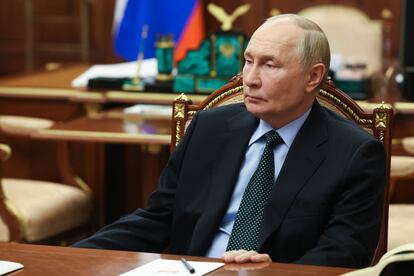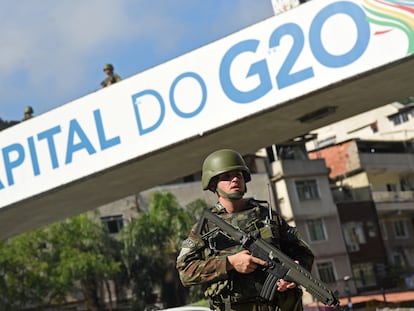Russia issues warning that a Ukrainian attack on its territory with US missiles will open a new phase in the war
According to the Kremlin, the use of Washington-supplied long-range weapons on Russian soil would mean that NATO countries would come into conflict with Moscow


The Kremlin on Monday underscored one of the red lines it has drawn since the start of its invasion of Ukraine: Washington’s permission for Kyiv to attack targets on Russian soil with long-range missiles supplied by the U.S. will lead to “a qualitative increase in the level of involvement of the United States in this conflict.” Vladimir Putin’s spokesman, Dmitry Peskov, recalled the words expressed by the Russian president in September, at the entrance to a cultural forum in St. Petersburg, where he warned that permission to use such weapons will mean that “NATO countries — the United States and European countries — are at war with Russia.”
Reuters, The New York Times and The Washington Post reported on Sunday that outgoing U.S. President Joe Biden has given permission to the Ukrainian army to use ATACMS missiles inside Russian territory, where military bases and airfields have been protected until now. According to the U.S. media, Washington has made a 180-degree turn in its policy toward the use of these weapons, at least until Donald Trump’s inauguration in two months, on January 20, 2025.
“It is obvious that the outgoing administration in Washington intends to take steps to continue adding fuel to the fire and continue to provoke tension around this conflict,” Peskov told Russian media on Monday.
The Biden administration has so far rejected the pleas of Ukrainian President Volodymyr Zelenskiy for fear of provoking a military escalation with Russia. “If such a decision has indeed been formulated and communicated to the Kyiv regime, then, of course, this is a qualitatively new round of escalation of tensions,” Putin’s spokesman stressed hours after the news broke.
In addition to issuing verbal warnings to the West, Russian authorities have also modified their nuclear doctrine. Putin met with the Security Council standing conference on nuclear deterrence in late September to discuss the new amendments. The meeting, which is usually secret, was broadcast on state television to send a message to the world.
Weapons of mass destruction
Among other changes, the Kremlin decided to consider a joint attack by a non-nuclear-weapon state as an “aggression” if it has the support of a nuclear power. In that case, the new doctrine would contemplate the use of weapons of mass destruction if necessary.
Moreover, Putin’s spokesman declined to comment on the veracity of Turkey’s alleged plan for a ceasefire in Ukraine, although he stressed that the Kremlin will not give up the entire Donetsk, Luhansk, Kherson and Zaporizhzhia regions. “Any option involving the freezing [of the conflict] along the line of engagement is unacceptable for Russia in any case. The conditions that President Putin laid out in June remain fully relevant. This is what needs to be done to stop military activities,” Peskov emphasized.
Bloomberg on Monday published some details of the proposal to be made by Turkish President Recep Tayyip Erdogan at the G-20 summit in Brazil to freeze the war along the current lines of battle. According to the U.S. news agency, Ankara will propose a veto on Ukraine’s accession to NATO within 10 years and the creation of a demilitarized zone in the east of the country with the presence of international troops.
A Turkish government source told Ria Novosti that Bloomberg’s revelation “does not correspond to reality.” However, his sources in the Turkish government told the Russian news agency that Erdogan will prioritize the discussion of a truce at the G-20. “The main task now is to stop the bloodshed and achieve a sustainable ceasefire,” the Russian agency reported.
Sign up for our weekly newsletter to get more English-language news coverage from EL PAÍS USA Edition
Tu suscripción se está usando en otro dispositivo
¿Quieres añadir otro usuario a tu suscripción?
Si continúas leyendo en este dispositivo, no se podrá leer en el otro.
FlechaTu suscripción se está usando en otro dispositivo y solo puedes acceder a EL PAÍS desde un dispositivo a la vez.
Si quieres compartir tu cuenta, cambia tu suscripción a la modalidad Premium, así podrás añadir otro usuario. Cada uno accederá con su propia cuenta de email, lo que os permitirá personalizar vuestra experiencia en EL PAÍS.
¿Tienes una suscripción de empresa? Accede aquí para contratar más cuentas.
En el caso de no saber quién está usando tu cuenta, te recomendamos cambiar tu contraseña aquí.
Si decides continuar compartiendo tu cuenta, este mensaje se mostrará en tu dispositivo y en el de la otra persona que está usando tu cuenta de forma indefinida, afectando a tu experiencia de lectura. Puedes consultar aquí los términos y condiciones de la suscripción digital.
More information
Archived In
Últimas noticias
Most viewed
- Reinhard Genzel, Nobel laureate in physics: ‘One-minute videos will never give you the truth’
- Oona Chaplin: ‘I told James Cameron that I was living in a treehouse and starting a permaculture project with a friend’
- Pablo Escobar’s hippos: A serious environmental problem, 40 years on
- Why we lost the habit of sleeping in two segments and how that changed our sense of time
- Chevy Chase, the beloved comedian who was a monster off camera: ‘Not everyone hated him, just the people who’ve worked with him’










































